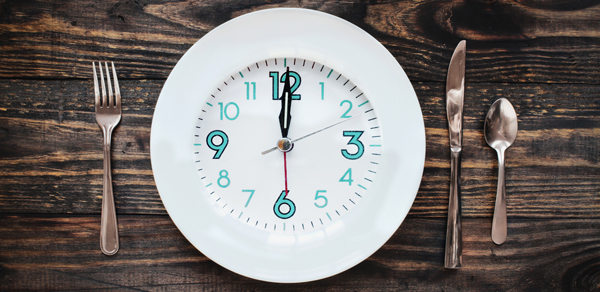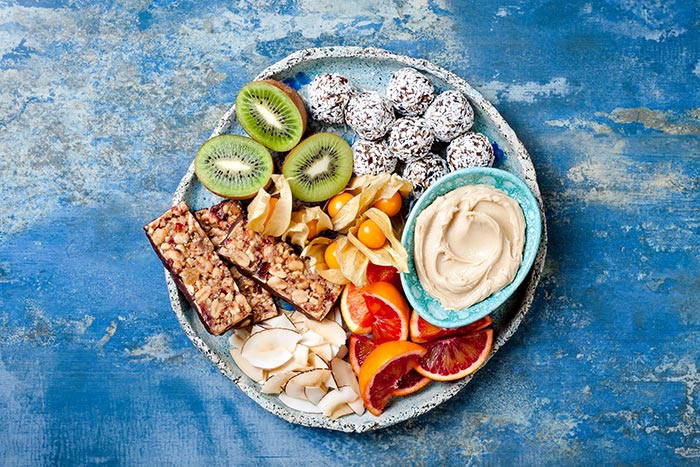Intermittent fasting was one of those things that got a lot of pushback early on. Now more and more people are accepting it. But why? If we think about what we have accustomed our bodies to we now are used to eating much larger portions than humans did decades and hundreds of years ago.
That’s why when studies released the potential health benefits of fasting many were hesitant to think “starving” yourself could be healthy. But as more people started trying the idea they realized that weight loss, improved brain function, control of blood sugar levels, and so many benefits came from this approach to weight loss.
So, how do we do it? Let’s take an in-depth look at 14-10 intermittent fasting and understand the safety precautions that need to be taken.
What is Intermittent Fasting?

Intermittent fasting is when you choose a time period that you are allowed to eat and a time period that you will fast or not eat. Most people try to do the 14 hours off and 10 hours on the method because of the science that backs it. This means eating within a 10-hour window. For instance, if you eat breakfast at 8 A.M. then your last meal should be finished by 6 P.M.
The Benefits
Let’s get right to the idea of why people choose to eat within this 10-hour window.
- Insulin resistance is built up with proper fasting. This means that you can get a better grip on your blood sugar levels. This can be particularly helpful for some people that struggle with diabetes. Thought, anyone with a pre-existing condition should speak with their doctor before trying a new diet or regimen. It also should be disclosed that blood sugar levels with fasting are different between men and women.
- Chronic inflammation is often associated with several health issues concerning the heart, various cancers, rheumatoid arthritis, etc. Fasting has been shown to reduce inflammation by reducing the c-reactive protein in the body.
- Fasting has the potential benefit to improve cholesterol and other heart health-related metrics. Studies have shown decreased blood pressure with certain fasting methods.
- Last but not least, fasting has a correlation with brain degenerative disorders and has been thought to boost brain function. Inflammation and neurodegenerative disorders go hand in hand.
Studies are still being conducted on fasting diets and methods to continue linking possible health benefits as well as find any known safety concerns.
The Downfalls
As with anything, there is a drawback and there is a few things that anyone considering fasting should know.
- Skipping meals can cause side effects such as dizziness, headaches, weakness, and so on. This is why it is important to not skip meals rather than contain them to a certain window.
- Fasting only works if you are disciplined. If you are consistent in your routines it potentially will provide minimal to no benefit. Even in some disciplined cases, it can lead to weight gain. The reason behind this is when the body thinks it is starving, its natural go-to is to try and hold onto the carbs and fat as long as possible to survive.
- For those who are not in a mental place to control their fasting, it can lead to eating disorders in general. It’s important to stick with your routine in both ways. Not to cheat but also not to overdo it. Fueling your body is important.
These are the main areas of concern. It shouldn’t scare you off but talking about this lifestyle with a nutritionist or a doctor is a great starting point for those who may be weary of the practice.
Let’s Get to Specifics: The 14-10
Let’s talk about the 14-10 intermittent fasting diet and how to do it. We explained the basic 10-hour window you get to eat during but what you eat matters! The 14/10 is often considered to be one of the best intermittent fasting styles to get started with if you have never done it before.
This is because the window is not outrageous compared to some diets. You can still get three full meals with no problem.
How To Do It
Let’s start by saying there is some flexibility in the diet. If you want to challenge yourself and move to two meals a day you can absolutely do this. But for starters, three is not a bad idea.
It’s important to not snack in between meals or drinks any high-calorie drinks that could hinder your progress. Here are the tips you will want to follow to have a successful fasting experience.
1. Only eat up to three meals a day. Just because you have a ten-hour window to eat doesn’t mean you should eat everything and anything. In fact, if you can limit it to two meals a day you are doing great.
- These meals should be high in protein, low in bad carbs, and overall healthy choices. This means eliminating as much sugar as possible as well as processed foods.
- Snacking is a big no-no. This is why it is important to make sure your meal is fulfilling enough so you don’t feel the need to dip into snacks.
- Drinking your calories is another big no-no. These are wasteful calories and won’t provide any nutritional benefit to you. Remember you are fasting to make a lifestyle change such as weight loss or healthy habits. Don’t hinder it with bad food or drinks.
2. The 10-hour window is up to the eater but there is something to be said for getting your calories in during the early morning. Naturally, our stomaches and metabolisms process food better in the earlier parts of the day. If you can get your first meal in by 7 A.M or earlier, this is great.
3. You can combine this with working out to get better results. It’s important to try and schedule your workouts near when you fuel your body. This prevents accidents and can help get your metabolism going.
4. Remaining hydrated is a crucial part of the process. Your stomach will be able to digest foods better when it is hydrated.
Meal Plan Example

It’s worth looking at a meal plan because everyone’s version of clean heating is slightly different. It’s also something that is one of many approaches as not everywhere approached the 14:10 the same way.
Monday, Wednesday, and Saturday
1. Breakfast at 7 A.M. Two eggs hard-boiled with pepper, sliced tomatoes, half an avocado, and a piece of wheat toast. A large glass of water with lemon. Do the water warm if you want to add extra benefits. Coffee is OK to have too as long as it’s black or only with a slash of skim or fat-free milk.
2. Lunch at 11 A.M. usually looks like a small serving of healthy nuts paired with a greens salad. Fill this with nutrient-rich greens like kale and spinach as well as peppers, onions, and other healthy vegetables. Throw on some protein like grilled chicken or fish.
3. Finished by 5 P.M. Dinner should be lean. Go ahead and grill or roast some vegetables like Brussels sprouts, squash, carrots, and so on. You should pair it with another source of lean protein. Keep mixing up your fish and chickens. Tofu is not a bad source to throw in every once in a while too.
Tuesday and Thursday
Tuesday and Thursday you can switch it up to try and do a meal replacement shake for your lunches and go a little heftier on your breakfast and dinner. This is to try and help satisfy cravings.
1. Breakfast is served at 7 A.M. This is when you should be finishing up eating. Today have an omelet filled with vegetables and spices to add flavor. You can add a bit of fruit to get vitamins but be aware of the amount of sugar you consume. Black coffee or tea as always.
2. Aim for noon for your snack. Instead of having lunch here, you can do a meal replacement shake that has a ton of protein in it. Make sure that it does in fact have some calories that can help fuel you. Aim for 40 grams of protein in the serving.
3. Eat dinner by 5 P.M. Dinner should be enjoyable. Add a little flavor to your dinner by having a steak with a wine reduction or a balsamic glaze. You can also add some flavoring to vegetables and have a little healthy dessert. This can be a sweet potato with peanut butter and dark chocolate. It’s delicious.
Sunday
Sunday can be your cheat day. What is a cheat day? Well, today you can let go of the restrictions completely. Some people continue to eat healthy while others increase their calorie intake and satisfy all their cravings. Whether you want pizza, sushi, or dessert it is all OK. This is why you see The Rock, going HAM on his cheat days. He earned it! Just remember a cheat day is one day a week in this case.
Healthy Cheat Desserts

- Protein pancakes are always a good go-to. Kodak makes pre-made heat-up waffles and pancakes sold at stores like Whole Foods and Target.
- Making your own pizza with wheat dough or cauliflower crust is one way to enjoy a healthy treat.
- Halo Top Ice Cream is severely underrated and has minimal calories and great flavors to choose from.
These are just a few examples to take a look at as there are thousands of ideas that you can get from going on Pinterest and different websites that offer healthy recipes. And no one said they have to be healthy. This is for the extra go-getters that want to maintain their weekly habits.
FAQ
This last section is dedicated to some of the most frequently asked questions. Most people find themselves adapting the 14:10 to their body and what works for them as long as it is reasonable.
How long does it take to see results from intermittent fasting at 14:10?
This is one of the most common questions. It can take a little bit of time to see results as it does with anything. Usually, you will start to notice results within the first few weeks. Generally between weeks 2-4. As the body starts to fast it will start to burn through the excess fat and therefore show a change in body composition.
Not all bodies react the same. Some bodies are capable of holding onto the excess fat for longer because of the way their metabolism works with their digestive system. Other things like food interfaces that create inflammation can also hinder the progress of a diet like this.
How does the 14:10 compare to other fasting diets?
The 14:10 is a simple entry into the fasting world. It is relatively easy to maintain and free of many rules. Now, common sense would say that if you are only burning 2,000 calories a day and you are eating 5,000 in that 10-hour window then it isn’t really fasting.
But when you compare it to other fasting methods like the 16-hour fast, it is much more maintainable and doable. It has great benefits like the others. For those who are able to challenge themselves and want to see more progressive results quickly.
Can I have zero-calorie drinks during my fast?
Many people often wonder what beverages they can have during a fast. It is so important not to drink your calories. That is why it is best to sit with water and lemon or black coffee. However, you can branch out and add a few zero-calorie drinks to your diet. However, you want to be sure not to spike your glucose levels.
This will ruin the metabolic effect or state that you put your body in to burn the excess fat. Certain drinks should be fine such as Coke Zero, Zest Tea, etc. If you notice a negative reaction head back to the water to avoid risking your progress.



